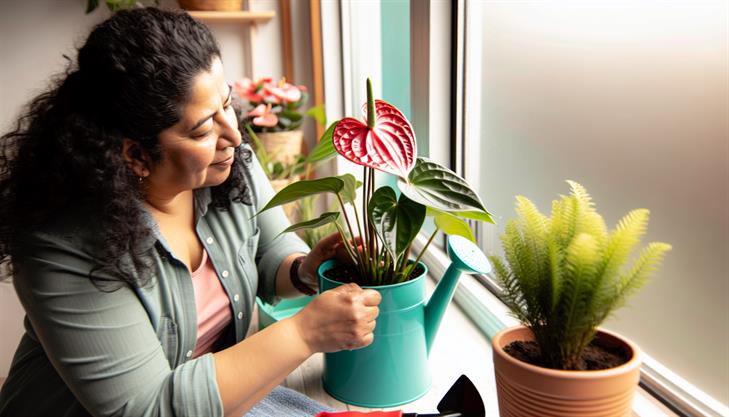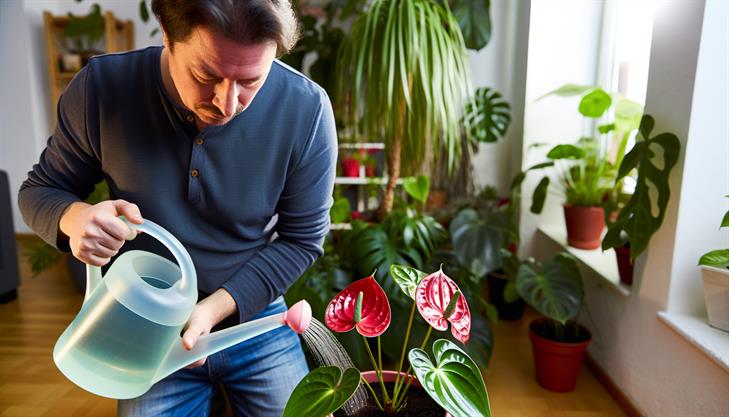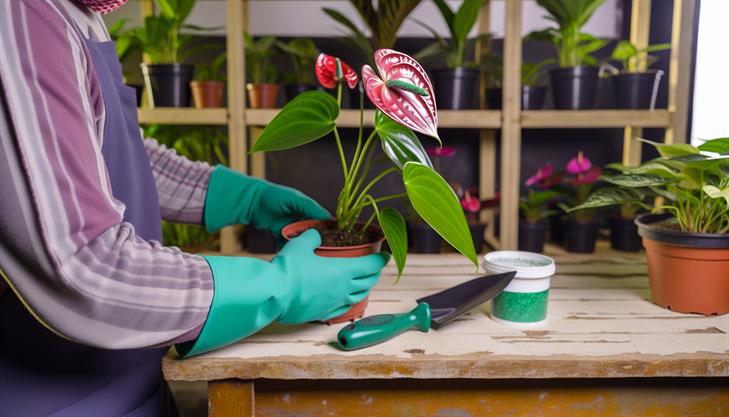In the realm of indoor gardening, few plants captivate the heart and brighten the home quite like the anthurium. Known for its glossy, heart-shaped leaves and bold, waxy blooms that stay vibrant year-round, the anthurium is a favorite not just for its striking appearance but also for its relatively low maintenance needs. But, as with any living beauty, ensuring a healthy, thriving anthurium requires a dash of knowledge and a sprinkle of care. Whether you’re a seasoned plant enthusiast or a newcomer nurturing your green thumb, mastering the art of anthurium care is crucial for keeping these stunning plants at their glorious best. Not only does proper care enhance their aesthetic appeal, but it also contributes to the air purity of your living space, making your home both more beautiful and healthier. In this comprehensive guide, we will delve into the essentials of anthurium care, offering you detailed insights and practical tips to help your anthurium flourish with minimal effort. Get ready to transform your home with these tropical marvels!
Understanding Anthurium Basics: Types and Growing Conditions
Anthuriums are stunning tropical plants known for their vibrant, waxy blossoms and glossy green foliage, often adding a touch of elegance to any indoor or outdoor space. Proper care is essential to maintain their beauty and ensure healthy growth. Here’s a step-by-step guide on how to care for anthuriums, including tips for optimal conditions and troubleshooting common issues.
1. Choosing the Right Location
Place your anthurium in a well-lit but indirect sunlight spot. Direct sunlight can scorch their leaves, while too little light may prevent blooming. A north or east-facing window is ideal, or you can use filtered light from a sheer curtain to shield them from harsh midday sun.
2. Selecting the Right Soil
Anthuriums thrive in a loose, well-draining potting mix rich in organic matter. A mix specifically formulated for orchids works well, or you can create your own with equal parts of peat, pine bark, and perlite. Avoid heavy garden soil as it retains too much moisture and can lead to root rot.
3. Watering Tips
Water your anthurium when the top inch of soil feels dry to the touch. Typically, this translates to watering every 1-2 weeks, but the frequency can vary depending on environmental conditions. Ensure the pot has drainage holes to prevent waterlogging. If the leaves start to yellow, it may be a sign of overwatering; reduce the frequency and check for proper drainage.
4. Humidity and Temperature Needs
Anthuriums enjoy high humidity levels typical of their native tropical environment. Maintain humidity levels around 60-80%. You can achieve this by placing a humidifier nearby, setting the pot on a tray with water and pebbles, or occasionally misting the leaves. Keep them in a temperature range of 65-80°F (18-27°C) and away from drafts, which can stress the plant.
5. Fertilizing Your Anthurium
Feed your anthurium with a balanced, water-soluble fertilizer diluted to half strength once every 6-8 weeks during the growing season (spring and summer). Too much fertilizer can burn the roots and lead to poor growth.
6. Pruning and Grooming
Regularly remove yellow or faded leaves to enhance appearance and prevent disease. To encourage blooming, cut spent flowers at the base once they start to wilt. This directs the plant’s energy toward new growth and flowers.
7. Repotting Requirements
Anthuriums prefer being slightly pot-bound, but they’ll need repotting every 2-3 years or when roots start growing out of the pot. Choose a pot one size larger and replenish with fresh potting mix to encourage continued growth.
Common Issues and Solutions
- Pest Problems: Look out for pests like aphids or spider mites. You can manage them with insecticidal soap or a neem oil solution.
- Brown Leaf Tips: This might signal low humidity or excessive fertilization. Increase moisture levels and review your feeding schedule.
- Blackening Leaves: This often indicates root rot from overwatering. Check drainage and reduce watering frequency accordingly.
By following these care tips consistently, your anthuriums can remain robust, flourishing with their enchanting blooms, and filling your space with unmatched beauty. Whether you’re new to caring for anthuriums or looking to refine your plant care tactics, these insights will help you maintain a thriving plant.
How to Water Anthuriums for Optimal Growth
Caring for anthuriums, also known as flamingo flowers or laceleaf plants, involves understanding their unique requirements to ensure they thrive. These tropical plants are known for their vibrant blooms and distinctive foliage, making them a favorite among indoor plant enthusiasts. Here’s a comprehensive guide on how to care for anthuriums, focusing on watering as well as other crucial aspects.
Understanding Anthurium Watering Needs
-
Determine the Right Frequency: Anthuriums prefer moist but not waterlogged soil. Typically, watering once a week is sufficient. However, this can vary based on environmental factors like humidity and temperature. To avoid overwatering, allow the top inch of soil to dry out between watering sessions.
-
Use Lukewarm Water: Cold water can shock the roots, so it’s best to use water at room temperature. This approach mimics the plant’s natural tropical habitat.
-
Water Evenly: Ensure even moisture distribution by slowly pouring water onto the soil until it begins to drain from the pot’s bottom. Let any excess water drain completely to prevent root rot.
-
Adapt to Humidity Levels: Anthuriums thrive in high humidity environments. If indoor air is dry, consider placing a humidifier nearby or setting your plant on a tray filled with pebbles and water to increase the surrounding humidity.
Soil and Potting Tips
-
Use Well-Draining Soil: A mix of orchid soil, peat moss, and perlite works well for anthuriums. This mix provides adequate drainage while retaining the necessary moisture.
-
Choose the Right Pot: Ensure your container has drainage holes to prevent water from collecting at the bottom. A pot that accommodates the plant’s root system with a bit of extra space is ideal.
Lighting Conditions
Anthuriums prefer bright, indirect light. Direct sunlight can scorch the leaves, while insufficient light may inhibit flowering. If natural light is limited, a grow light can be an effective alternative.
Fertilization and Maintenance
-
Opt for Balanced Fertilizers: Feed your anthuriums with a balanced liquid fertilizer every two months during the growing season (spring and summer). Reduce feeding in fall and winter when the plant’s growth naturally slows down.
-
Regular Maintenance: Remove any dead or yellowing leaves to encourage healthy growth. Dust the leaves occasionally to facilitate better photosynthesis, and prune back stems as needed to maintain shape and size.
Common Issues and Remedies
-
Leaf Yellowing: Often a sign of overwatering or lack of nutrients. Adjust your watering schedule and ensure you are using a suitable fertilizer.
-
Brown Leaf Tips: This can be due to underwatering, low humidity, or excessive fertilizer. Implement regular misting and monitor your fertilization routine.
-
Pests: Aphids, spider mites, and mealybugs can be attracted to anthuriums. Treat infestations with neem oil or insecticidal soap.
By following these steps and adjusting your care routine based on your plant’s environment, you can ensure your anthuriums not only survive but flourish, displaying their iconic, vivid blooms. Remember, patient observation and adaptation are key to mastering how to care for anthuriums effectively.
Tips for Ensuring the Right Light and Temperature
Caring for anthuriums requires attention to their specific light and temperature needs, alongside other essential care practices. These tropical plants, known for their vibrant flowers and glossy leaves, can thrive indoors with proper care. Here’s how to care for anthuriums effectively:
1. Light Requirements
Anthuriums flourish in bright, indirect light. Too much direct sunlight can scorch the leaves, while too little light may result in poor flowering and leggy growth. Ideally, place your anthurium near an east or north-facing window shielded by a sheer curtain. If natural light is insufficient, consider using fluorescent lighting to ensure the plant receives the necessary illumination.
2. Temperature Preferences
Anthuriums prefer warm and stable temperatures ranging from 65°F to 85°F (18°C to 29°C). Keep the plant away from cold drafts, air conditioning vents, and sudden temperature changes, which can stress the plant. If your environment is cooler, use a heat mat to maintain optimal temperatures.
3. Humidity Levels
High humidity is crucial for anthuriums’ health. Aim for at least 60% humidity, as insufficient moisture can cause the leaves to brown. To increase humidity, mist the plant regularly with water, place a humidifier nearby, or situate the pot on a tray filled with pebbles and water. Make sure the pot doesn’t sit directly in the water to prevent root rot.
4. Watering Schedule
Water anthuriums thoroughly, but let the top inch of the soil dry out before the next watering. Overwatering can lead to root rot, so ensuring proper drainage is critical. Use tepid, chlorine-free water to avoid shocking the plant and maintain soil moisture without waterlogging.
5. Potting and Soil
Choose a well-draining potting mix rich in organic matter. A mix of orchid bark, perlite, and peat moss works well to simulate the anthurium’s natural habitat. Repot every two years or when the plant outgrows its container, typically in spring, to refresh the soil and manage root growth.
6. Fertilization Needs
During the growing season (spring and summer), feed anthuriums every 4-6 weeks with a balanced, water-soluble fertilizer diluted to half-strength. Too much fertilizer can lead to salt buildup, so it’s important to flush the soil with water periodically to remove excess salts.
Common Issues and Troubleshooting
- Yellow Leaves: Often a sign of overwatering or poor drainage. Adjust your watering schedule and ensure the potting mix offers proper aeration.
- Brown Leaf Tips: Usually caused by low humidity or lack of water. Increase humidity and check your watering consistency.
- No Flowers: Insufficient light is often the culprit. Ensure your anthurium receives the recommended light intensity.
Additional Advice
Regularly clean the leaves with a damp cloth to remove dust and allow the plant to photosynthesize effectively. Keep an eye out for pests such as spider mites and aphids, which can be treated with insecticidal soap or neem oil when detected early.
With mindful care and attention to their environmental needs, anthuriums can be a stunning and enduring addition to your indoor plant collection. By following these guidelines on how to care for anthuriums, you can enjoy their exotic beauty year-round.
Expert Guide to Fertilizing and Repotting Anthuriums
Caring for anthuriums, renowned for their vibrant blooms and glossy foliage, involves understanding their specific needs regarding fertilizing and repotting. Following a detailed approach can ensure healthy growth and vibrant flowers. Here’s a comprehensive guide on how to care for anthuriums:
Fertilizing Anthuriums
-
Choose the Right Fertilizer: Opt for a balanced, water-soluble fertilizer with a ratio of 3:1:2 (Nitrogen:Phosphorus:Potassium). This type supports healthy foliage and robust flowering.
-
Frequency of Fertilization: Apply fertilizer every 6 to 8 weeks during the growing season, typically spring through early autumn. Reduce the frequency in winter when the plant is not active.
-
Application Method: Dilute the fertilizer to half the recommended strength to avoid root burn. Pour the solution evenly around the base of the plant, ensuring the soil is moist before application.
Repotting Anthuriums
-
When to Repot: Repot every two to three years or when roots start wrapping around the pot’s edges, indicating they are root-bound.
-
Choosing the Right Pot and Soil:
- Select a pot that is one size larger than the current container.
- Use a well-draining potting mix, ideally a blend designed for orchids, as it contains materials like pine bark and coconut coir that promote aeration.
-
Step-by-Step Repotting Guide:
- Remove the Plant: Gently taper the edges of the current pot to loosen the root ball. Carefully extract the plant.
- Prune the Roots: Trim away any brown or rotting roots using sterilized scissors.
- Prepare the New Pot: Place a layer of fresh potting mix at the bottom of the new pot.
- Position the Anthurium: Situate the plant in the center, filling in with soil around the edges. Press the soil lightly to secure the plant.
- Water Thoroughly: Water the plant to help the roots settle in the new environment.
Additional Tips for Anthurium Care
-
Light Requirements: Place anthuriums in bright, indirect sunlight. Direct sunlight can scorch the leaves, while insufficient light can reduce flowering.
-
Humidity Considerations: Anthuriums thrive in high humidity. If your home is dry, consider using a humidifier or placing the plant on a tray of water with pebbles.
-
Watering Schedule: Water when the top inch of soil feels dry. Overwatering can lead to root rot, so ensure excess water drains away.
Common Issues and Solutions
-
Yellow Leaves: Often a sign of overwatering or insufficient light. Adjust watering habits and light exposure accordingly.
-
Brown Tips: This may indicate low humidity, so increase ambient moisture or mist the leaves regularly.
By following these guidelines on how to care for anthuriums, you can enjoy lush growth and vibrant blooms. Consistent care and attention to their specific needs will ensure they remain a stunning part of your indoor plant collection.
Troubleshooting Common Anthurium Care Problems
Caring for anthuriums, often referred to as "flamingo flowers" due to their bright and exotic appearance, can be both rewarding and straightforward when you understand their needs. These beautiful plants thrive with the right care routine. Here’s a step-by-step guide on how to care for anthuriums, ensuring they remain vibrant and healthy.
1. Optimal Light Conditions
Anthuriums do best in bright, indirect light. Direct sunlight can scorch their leaves, while too little light may result in fewer blooms and slower growth. If possible, place your anthurium near an east or north-facing window. If natural light is limited, a grow light can be a helpful addition to your setup, ensuring the plant receives adequate light without the risk of burn.
2. Ideal Temperature and Humidity
Anthuriums prefer temperatures between 65-85°F (18-29°C). They are sensitive to temperature fluctuations, so avoid placing them near drafts, air conditioning units, or heaters. High humidity is beneficial for anthuriums. To maintain optimal humidity levels, consider using a humidity tray or misting the leaves regularly. In dry climates, a humidifier can also be a valuable tool in caring for anthuriums.
3. Watering Tips
Consistent watering is key to keeping anthuriums healthy. Water your plant when the top inch of soil feels dry to the touch. Overwatering can lead to root rot, so ensure the pot has drainage holes to allow excess water to escape. During the winter months, when growth slows, reduce watering frequency, always checking soil moisture beforehand.
4. Soil and Repotting
Anthuriums thrive in well-draining potting mix rich in organic matter. A mix of equal parts peat moss, pine bark, and perlite usually works well. Repot your anthurium every 2-3 years or when you notice roots protruding from drainage holes. When repotting, choose a pot that is 1-2 sizes larger than the current one, allowing the roots adequate space to grow.
5. Fertilization
To encourage vibrant blooms and healthy foliage, feed your anthurium with a balanced liquid fertilizer every 6-8 weeks during the growing season (spring and summer). Dilute the fertilizer to half strength to avoid nutrient burn. Reduce feeding during the fall and winter months when the plant’s growth naturally slows down.
Common Issues and Troubleshooting
- Yellow Leaves: Often indicate overwatering or poor drainage. Check the soil moisture and adjust your watering routine accordingly. Improving drainage by mixing perlite into the soil can also help.
- Brown Edges or Tips: Could be a sign of low humidity or too much direct sunlight. Increase humidity around the plant and relocate it to a spot with indirect light.
- Fewer Blooms: If your anthurium isn’t blooming, it may be due to inadequate light, poor nutrition, or the wrong temperature. Ensure the plant receives sufficient indirect sunlight and is fed regularly during the growing season.
Additional Tips
- Dusting Leaves: Regularly wipe the leaves with a damp cloth to remove dust, which can hinder photosynthesis.
- Pests Management: Keep an eye out for pests such as aphids or spider mites. If they appear, treat the plant with insecticidal soap or a homemade solution of water and mild dish soap.
By following these care tips and staying attentive to your plant’s needs, you can enjoy a flourishing anthurium that enhances your living space with its vibrant foliage and striking flowers.
In conclusion, caring for anthuriums can be a rewarding experience with their striking blooms and lush foliage. By understanding and maintaining the right balance of light, water, and humidity, you can help your anthuriums thrive. Remember to provide them with indirect sunlight, keep the soil consistently moist but not waterlogged, and ensure a humid environment that mimics their natural habitat. Regular feeding with a balanced fertilizer during the growing season can also enhance their vibrant growth.
By applying these care tips, you’ll not only promote the health and beauty of your anthuriums but also enjoy the vibrant atmosphere they bring to your space. As a final recommendation, consider placing your anthuriums in a well-ventilated room where air circulation can prevent issues like fungal growth, and allow your plants to breathe freely. Embrace these steps and watch your anthuriums flourish, bringing a touch of tropical elegance to your home.


